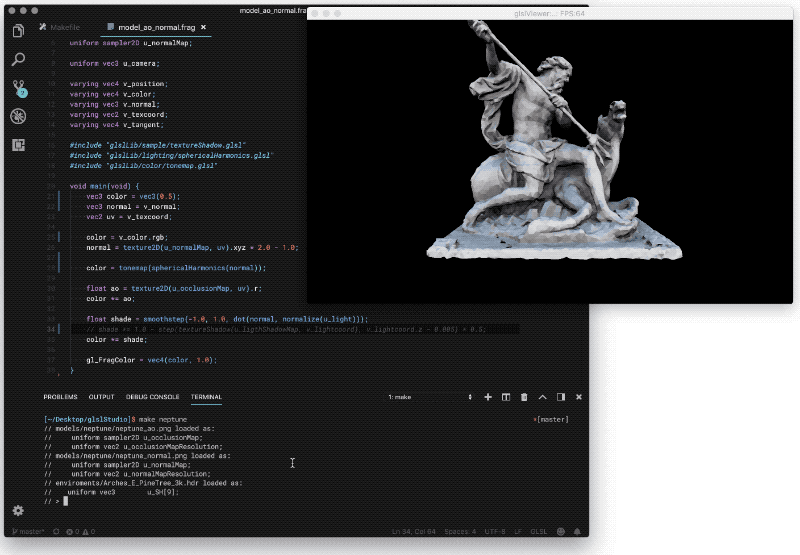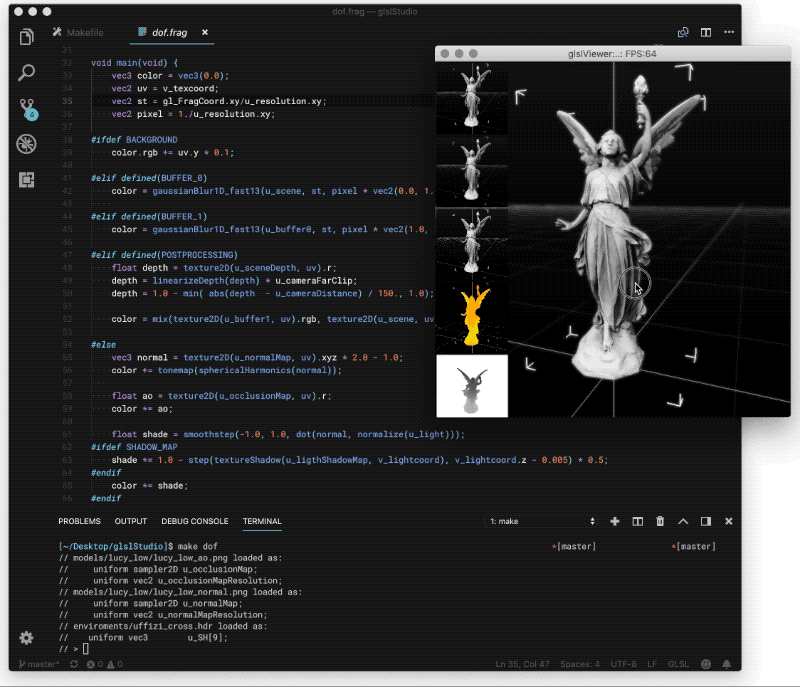GlslViewer is a flexible console-base OpenGL Sandbox to display 2D/3D GLSL shaders without the need of an UI. You can definitely make your own UI or wrapper using the Python Module (include) or any other tool that communicates back/forth with glslViewer thought the standard POSIX console In/Out or OSC.
GlslViewer support both 2D shaders and/or 3D shaders when a geometry (LST, PLY, OBJ or GLTF) is provided.
GlslViewer gives support to:
- fragment and vertex shaders on GLSL 120
- resolve #include dependencies
- adding/deleting #define keys through console IN commands and OSC
- automatically generated set of defines based on the platform, buffer, render pass, geometry attributes and materials properties.
- passing custom uniforms (float, int, vec2, vec3 and vec4) through console IN or OSC
- import of Textures (png, bmp, jpg, tga, hdr and gif)
- import of Cubemaps and spherical harmonics (png, jpg, tga, hdr)
- import LST, PLY, OBJ or GLTF files (and their dependencies)
- default vert/frag shaders with PBR lighting model
- hot reload of files on changes
- One default light and one default camera
- Interactive commands thought POSIX console IN/OUT or OSC
- different debug modes (histogram, textures, buffers, bounding box, etc)
- shadow maps
- headless rendering
- fullscreen and screensaver mode
- image export
- PNG sequence export
-
Convention:
[ ] Support for GL (Full KMS) or GL (Fake KMS) on RaspberryPi
[ ] Depth frag shader for scene depthmap ( u_sceneDepth ) instead of rendering to multiple targets ( only on RPI )
[ ] Depth frag shader for light's shadowMap, to work on RPI
Patricio Gonzalez Vivo: github | twitter | instagram | website
Thanks to:
-
Mihai Sebea for making the Windows compile happen
-
Karim Naaki lot of concept and code was inspired by this two projects: fragTool and hdreffects
-
Doug Moen he help to add the compatibility to ShaderToy shaders and some RayMarching features were added for his integration with his project: curv.
-
Wray implement the OSC listener feature, opening GlslViewer to an entire new ways of communicating and interacting with other apps, devices and ecosystems.
-
Yvan Sraka for putting the code in shape and setting it up for TravisCI.
-
Andsz for Spherical Harmonics code from Spherical Harmonics Playground
-
Syoyo Fujita for the work on tinyobjloader v1.0.x
-
Morgan McGuire's for the OBJ models on Computer Graphics Archive
-
Philip Rideout and Romain Guy general generosity to share their code and experience
-
Mihai Sebea for porting it to windows(TM)




